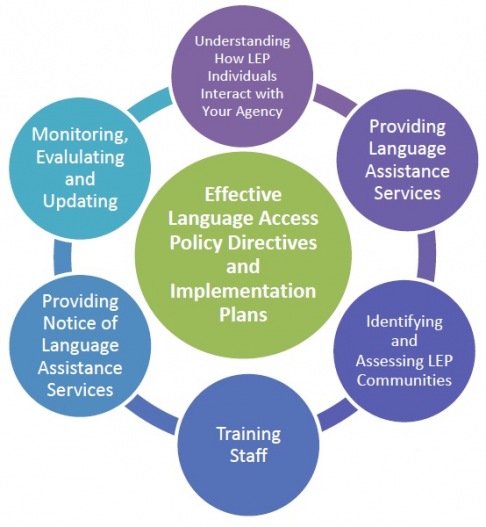6 Ways to Build an Effective Language Access Policy and Implementation Plan

As government assisted plans reassess efficacy, efforts to “effectively communicate with members of the public depend on the widespread and nondiscriminatory availability of accurate, timely and vital information” (Attorney General Eric Holder, Memorandum to All Federal Agencies Regarding Executive Order 13166, February 17, 2011).
The Department of Justice Federal Coordination and Compliance Section published an insightful tool for healthcare providers – Language Access Assessment and Planning Tool for Federally Conducted and Federally Assisted Programs – to help improve and innovate policies and implementation plans for LEP populations. We wanted to share their 6-pronged approach, but look at the full guide for sample assessments and policy directives.
Source: Language Access Assessment and Planning Tool for Federally Conducted and Federally Assisted Programs
1. Identifying and Assessing LEP Communities
Providers have many resources available to identify the demographics of LEP populations in their area, including resources from federal agencies, state and local government agencies, and local community-based and religious organizations. Data on LEPs interacting with your facility can also be tracked and stored by incorporating mandatory fields in registration paperwork.
2. Understanding How LEP Individuals Interact with Your Agency
It’s important to remember that almost every aspect of a program can affect the access of LEPs to services. Providers should identify methods to open communication in every way possible, including brochures, public meetings, in-house language capabilities, written correspondence, outreach programs and complaint forms. Identifying each way an LEP might fall through the cracks is tedious, but keeping LEPs informed through the whole cycle of interaction is key.
3. Providing Language Assistance Services
All written and spoken services should be provided in an LEP’s native language, employing a long list of language assistance services: bilingual staff, interpretation (in-person, telephonic, video, simultaneous) and document translation. Make sure employees and contractors who perform these duties are qualified, by using recognized assessment tools.
4. Training Staff on Policies and Procedures
Meaningful access to your programs starts with informed employees who can guide LEPs to the resources they need. Make sure that employees receive orientation and maintenance trainings on how to identify an LEP and make language services available.
5. Providing Notice of Language Assistance Services
Providers can use posters placed conspicuously through your facility to clearly demonstrate the availability of language assistance services for LEPs. But it doesn’t stop there. The use of “I Speak” cards and written notice of language services at every step of interaction provided in person, mail, telephone and electronically is critical.
6. Monitoring, Evaluating, and Updating the Language Access Policy Directives, Plans and Procedures
Monitoring and evaluation is an ongoing process for quality assurance of your program’s language services. Employ tools like staff surveys, customer satisfaction surveys, observation, feedback from community-based organizations, response rates to complaints and constantly updating your records of community demographics.
Diligence and innovation open avenues for consistent progress and improvement. Some organizations have established specific offices of standards to ensure benchmarks are met. These offices work in conjunction with department leaders and IT departments to make sure solutions are user-friendly and effective. In the end, follow the advice available from years of research, but listen to your employees and don’t be afraid to get innovative.
Source: Language Access Assessment and Planning Tool for Federally Conducted and Federally Assisted Programs